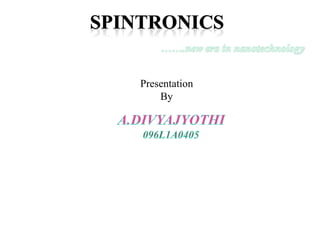
Spintronics
- 1. Presentation By
- 2. •Introduction •GMR •Devices •Future Demand •Conclusion •Advantages and Disadvantages •References
- 3. Spintronics is a NANO technology which deals with spin dependent properties of an electron instead of charge dependent properties
- 4. •Spin is a quantum mechanical property •The rotational moment creates a small magnetic field •The electron spin given a direction up or down •The up and down direction given a of (1) or (0) same thing as the electron positive or negative charge correspond to those values •Key concept is controlling the spin of electrons
- 5. What Is Spintronics ? • In conventional electronics, electron charge is used for manipulation, storage, and transfer of information . • Spintronics uses electron spins in addition to or in place of the electron charge.
- 6. Why We Need Spintronics ! Failure of Moore’s Law : Moore’s Law states that the number of transistors on a silicon chip will roughly double every eighteen months. But now the transistors & other components have reached nanoscale dimensions and further reducing the size would lead to: 1. Scorching heat making making the circuit inoperable. 2. Also Quantum effects come into play at nanoscale dimensions. So the size of transistors & other components cannot be reduced further.
- 7. • 1988 France, GMR discovery is accepted as birth of spintronics • A Giant MagnetoResistive device is made of at least two ferromagnetic layers separated by a spacer layer • When the magnetization of the two outside layers is aligned, lowest resistance • Conversely when magnetization vectors are antiparallel, high R • Small fields can produce big effects • parallel and perpendicular current
- 8. Gaint Magnetoresistance (GMR) The basic GMR device consists of a layer of non -magnetic metal between two two magnetic layers. A current consisting of spin-up and spin-down electrons is passed through the layers. Those oriented in the same direction as the electron spins in a magnetic layer pass through quite easily while those oriented in the opposite direction are scattered.
- 9. Advantage Spintronics Low power consumption. Less heat dissipation. Spintronic memory is non-volatile. Takes up lesser space on chip, thus more compact. Spin manipulation is faster , so greater read & write speed. Spintronics does not require unique and specialized semiconductors. Common metals such as Fe, Al, Ag , etc. can be used.
- 10. 1. MRAM (Magnetoresistive Random access) 2. Spin Transistor 3. Quantum Computer
- 11. •MRAM uses magnetic storage elements instead of electric used in conventional RAM •Tunnel junctions are used to read the information stored in Magnetoresistive Random Access Memory, typically a”0” for zero point magnetization state and “1” for antiparallel state
- 12. MRAM Magneto resistive RAM Array structure of MRAM •Reading: transistor of the selected bit cell turned ‘on’ + current applied in the bit line • Writing: transistor of the selected bit cell turned ‘off’ + currents applied in the bit and word lines •Need of 2 magnetic fields for writing
- 13. •Current passed through a magnetic field becomes spin polarized •Ideal use of MRAM would utilize control of the spin channels of the current •Spin transistors would allow control of the spin current in the same manner that conventional transistors can switch charge currents •Using arrays of these spin transistors, MRAM will combine storage, detection, logic and communication capabilities on a single chip •This will remove the distinction between working memory and storage, combining functionality of many devices into one
- 14. •The Datta Das Spin Transistor was first spin device proposed for metal- oxide geometry, 1989 •Emitter and collector are ferromagnetic with parallel magnetizations •The gate provides magnetic field •Current is modulated by the degree of precession in electron spin
- 15. A Quantum computer, in contrast, lies on encoding information within t quantum bits or qubits, each of which can exist in a superposition of ‘0’ and ‘1’.
- 16. •Moore’s Law states that the number of transistors on a silicon chip will roughly double every eighteen months •By 2008, it is projected that the width of the electrodes in a microprocessor will be 45nm across •As electronic devices become smaller, quantum properties of the wavelike nature of electrons are no longer negligible •Spintronic devices offer the possibility of enhanced functionality, higher speed, and reduced power consumption
- 17. Advantages Disadvantages .low power consumption .Controlling the spin for long . Multi purpose devices distances (amplifiers) .Combining techniques .No electric current between the required semiconductor and magnetic .Faster Devices recording industry .Larger storage capacity .Difficult to inject and .Smaller devices measure spin in silicon .Silicon causes electrons to lose their spin state
- 18. MRAM vs …..
- 20. This technology will exploit the spin of the electron and create new devices and circuits which could be more beneficial in future by providing devices like memories for data base accessing with the speed of light. The devices of this technology are very useful for transaction processing and for scientific number crunching. Moreover, these "spintronic" devices might lead to quantum computers and quantum communication based on electronic solid-state devices, thus changing the perspective of information technology in the 21st century
Hinweis der Redaktion
- Spin does not replace charge current just provide extra control Using suitable materials, many different “bit” states can be interpreted